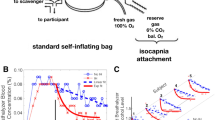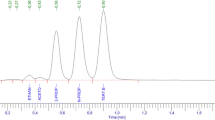Summary
Exposure of rats to 20 ppm CS2 (the current MAC in various countries) for 8 h was followed by i.p. administration of 2 g/kg ethanol (blood level: 3-1‰) and another up to 4-h exposure to the same concentration of CS2. During the second exposure the acetaldehyde concentration increased significantly, the rise representing one third of the control values. Inhalation of 400 ppm CS2 for the same period, or 8-h exposures at 400 ppm CS2 on 5 consecutive days produced only a slight additional increase in acetaldehyde. The increased appearance of acetaldehyde in blood is considered to be due to inhibition of aldehyde dehydrogenase by CS2. This conclusion was derived from the significant lag in the clearance rate of acetaldehyde given i.v. (1 mmol/kg) after exposure at 400 ppm CS2/8 h, involving an increase of the excretion half-life of acetaldehyde (1 min, 45 s in the controls) to 2 min, 24 s. The finding thus obtained could be reproduced in man (adult males). At a blood alcohol concentration of approximately 0.75‰, maintained at this level for 8 h, the blood acetaldehyde concentration was found to be approximately 6 × 10−3‰; it rose significantly by about 50% during simultaneous 8-h exposure of the test subjects to a nonfluctuating, analytically defined concentration of 20 ppm CS2. When increasing the dose Of CS2 to 40 ppm and 80 ppm for 8 h, only a slight additional increase was noted. Administration of ethanol (ca. 0./5‰) for 8 h, instituted at 16 h after 8-h inhalation of 20 ppm CS2, produced a rise in blood acetaldehyde to slightly more than twice the control value. An approximately identical quantitative effect was observed after exposure to 20 ppm on 5 consecutive days at the same time of the day (8.00 a.m. - 4.00 p.m.). Under the conditions employed, there was no evidence of any subjective or objective signs of alcohol intolerance in terms of an “antabuse syndrome” in the experiments. Inhalation of CS2 vapor failed to exert a significant effect on the pharmacokinetic behavior of ethanol in with a blood alcohol content up to 0.8%., contact with CS2 is not likely to give rise to a CS2-alcohol reaction, provided the concentrations of CS2 encountered in the work environment are within the range of the MAC.
Similar content being viewed by others
References
Battista, H.J.: Automatische Differenzierung der Blutproben und Zuordnung der Korrekturfaktoren bei der Computer-gesteuerten gaschromatographischen Blutalkoholbestimmung. Z.Rechtsmed. 72, 278–282 (1973)
Baugrand: Cited by Roger et al. (1925)
Dalvi, R.R., Poore, R.E., Neal, R.A.: Studies of the metabolism of carbon disulfide by rat liver microsomes. Life Sci. 14, 1785–1796 (1974)
Demus, H.: Beitrag zum Mechanismus der Aufnahme des Schwefelkohlenstoffs beim Einatmen und sein Verbleib im menschlichen Körper. Faserforsch. Tex-tiltechn. 4, 22–23 (1953)
Djurić, D.: Some aspects of CS2 and TETD metabolism. 4th Congr. Europ. Ass. Pois. Contr. Cent. Sept. 6–9, 1970, in Basko Polje/Yugoslavia, abstracts, p.87 (1970)
Djurić, D.: Some aspects of antabuse, carbon disulphide and ethyl alcohol metabolism. Arh.hig.rada 22, 171–177 (1971)
Duritz, G., Truitt, E.B.: A rapid method for the simultaneous determination of acetaldehyde and ethanol in blood using gas chromatography. Quart. J. Stud. Alcohol 25, 498–510 (1964)
Freundt, K.J.: On the pharmacokinetics of the ethanol metabolite acetate: elimination from the blood and cerebrospinal fluid. Arzneimittel-Forsch. (Drug Res.) 23, 949–951 (1973)
Freundt, K.J., Dreher, W.: Inhibition of drug metabolism by small concentrations of carbon disulfide. Naunyn-Schmiedeberg's Arch. exp. Path. Pharmak. 263, 208–209 (1969)
Freundt, K.J., Kuttner, P., Dreher, W.: Specificity and sensitivity of the inhibition of drug metabolism following inhalation of carbon disulphide-air mixtures. Arzneimittel-Forsch. (Drug Res.) (in press)
Freundt, K.J., Liebaldt, G.P., Sieber, K.-H.M.: Effect of barbiturates on the liver of rats exposed to carbon disulphide vapour. Int.Arch.Arbeitsmed. 32, 297–303 (1974)
Freundt, K.J., Lieberwirth, H.: Verhalten einiger klinisch-chemischer Parameter im Serum von alkoholisierten Personen nach kontinuierlicher Schwefelkohlenstoff-Inhalation. Zbl. Arbeitsmed. Arbeitsschutz 24, 266–271 (1974)
Freundt, K.J., Netz, H.: Influence of carbon disulfide and thiurams on ethanol elimination and acetaldehyde production. Naunyn-Schmiedeberg's Arch. Pharmac. Suppl. to 277, R 18 (1973)
Freundt, K.J., Schnapp, E., Dreher, W.: Pharmacokinetics of inhaled carbon disulphide in rats in relation to its inhibitory effect on the side-chain oxidation of hexobarbital. Int. Arch. Occup. Environ. Hlth 35, 173–185 (1975)
Jacobsen, E.: Neues über die theoretische Grundlage der Disulfiramwirkung (Antabus). Med. Welt 18, 2169–2173 (1967)
Machata, G.: Über die gaschromatographische Blutalkoholbestimmung. Blutalkohol 4, 252–260 (1967)
Mack, T., Freundt, K.J., Henschler, D.: Inhibition of oxidative N-demethylation in man by low doses of inhaled carbon disulphide. Biochem. Pharmacol. 23, 607–614 (1974)
Massmann, W., Strenge, K.: Beitrag zur Bestimmung von Schwefelkohlenstoff im Blut. Arch.Toxikol. 16, 58–63 (1957)
Münchinger, R.: Untersuchungen über die Schwefelkohlenstoffwirkung in der Viskose-Industrie. Z. Präv. Med. 3, 285–286 (1958)
Nyman, H.T., Satery, O., Walkeakoski, S.: Problems of chronic CS2 poisoning in a finish rayon mill. Groupe international de documentation sur la viscose, Bull. No.11, p.3 (1963)
Pergal, M., Vukojević, N., Cirin-Popov, N., Djurić, D., Bojović, T.: Carbon disulfide metabolites excreted in the urine of exposed workers. I. Isolation and identification of 2-mercapto-2-thiazolinone-5. Arch.Environ. Hlth 25, 38–41 (1972a)
Pergal, M., Vukojević, N., Djurić, D.: Carbon disulfide metabolites excreted in the urine of exposed workers. II. Isolation and identification of thiocarbamide. Arch. Environ. Hlth 25, 42–44 (1972b)
Rodenacker, G.: Die chemischen Gewerbekrankheiten, p. 161. Leipzig: Barth 1951
Roger, G.H., Widal, F., Teissier, P.J.: Nouveau trait & de médecine, Vol.VI, Intoxications, p. 203. Paris: Masson 1925
Souček, B.: Sirouhlík a antabus (Schwefelkohlenstoff and Antabus). Pracov. lék. 9, 21–22 (1957)
Souček, B., Mádlo, Z.: Dithiocarbamincarbonsauren als Abbauprodukte des Schwefelkohlenstoffs. Arch. Gewerbepath. Gewerbehyg. 14, 511–521 (1956)
Teisinger, J., Souček, B.: Absorption and elimination of carbon disulfide in man. J. industr. Hyg. Toxicol. 31, 67–73 (1949)
Weber, E.: Grundriß der biologischen Statistik, pp. 237–269. Jena: Grundriß der biologischen Statistik, pp. 1961
Winne, D.: Zur Auswertung von Versuchsergebnissen: Die Prüfung, ob Kurven sich in ihrem Verlauf unterscheiden. Naunyn-Schmiedeberg's Arch. exp. Path. Pharmak. 250, 383–396 (1965)
Author information
Authors and Affiliations
Rights and permissions
About this article
Cite this article
Freundt, K.J., Lieberwirth, K., Netz, H. et al. Blood acetaldehyde in alcoholized rats and humans during inhalation of carbon disulphide vapor. Int. Arch Occup Environ Heath 37, 35–46 (1976). https://doi.org/10.1007/BF00409362
Received:
Accepted:
Issue Date:
DOI: https://doi.org/10.1007/BF00409362




